Are you finally taking the leap into the world of native advertising? That's fantastic! But wait, are you grappling with reaching the right customers?
You're not alone in this conundrum; many businesses struggle to find the perfect audience for their native ads.
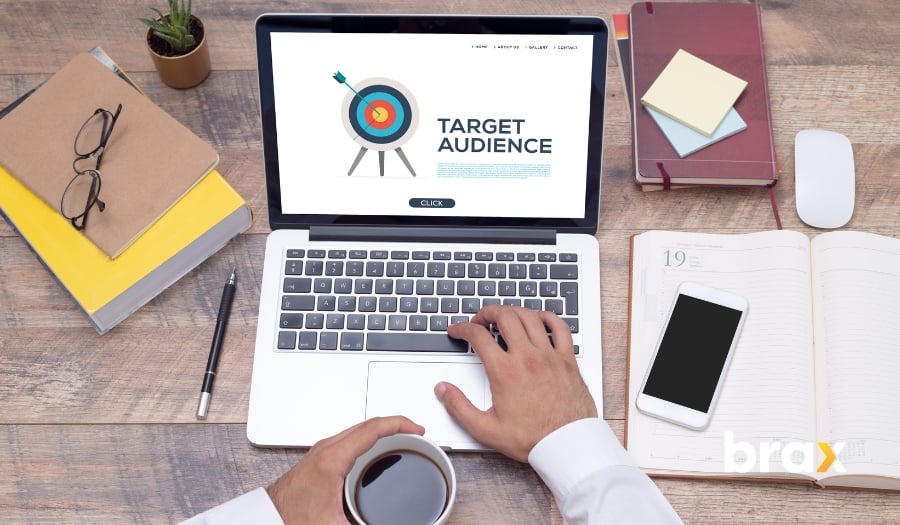
However, the cornerstone of the success of any native advertising campaign lies in effective targeting. You might be wondering... how exactly can this be achieved?
Well, have no fear! We’ve assembled some guidelines on the various targeting options of the top native ad platforms.
But first...
Is Audience Targeting in Native Ads Important?
Mastering the art of audience targeting is a pivotal step in creating successful native ads. Especially when it comes to native advertising, it's all about hitting the right spot!
Audience targeting allows advertisers to show ads to specific demographics, interests, behaviors, and locations.
This level of customization results in native ads that feel more personalized and relevant to the viewer, thereby increasing engagement rates.
Audience targeting in native ads is crucial. When done right, it ensures your native advertising gets the eyes of those who will likely interact and convert. This leads to a higher ROI. It boosts the power of your marketing efforts.
But what happens when audience targeting is done poorly or not at all? The results can be catastrophic.
Let's demonstrate:
A few years back, I studied an up-and-coming brand selling luxury watches. They launched a native ad campaign without audience targeting.
Their native ads were popping up on sites swarmed by teenagers and young adults. Not exactly the demographic with the financial means for such high-end items.
The outcome? Terrible click-through rates. Even worse conversion rates. Thousands of dollars went down the drain on ads that were either overlooked or ridiculed.
After checking their campaigns, I found that they weren't choosing the right target filters, so the native ads weren't being shown to the people who had the best chance of becoming a customer.
They then understood that knowing their audience and tailoring their ads to reach them wasn't a choice—it was a must. After adopting targeted strategies like focusing on platforms frequented by wealthy adults with an interest in luxury goods, selecting devices based on price or brand, their campaigns took a turn for the better.
Bottom line: Audience targeting in native ads isn't just important—it's revolutionary.
Because:
- It allows you to deliver content that resonates with the right people.
- It increases your chances of engagement and conversion, making your ad efforts more efficient.
- Failing to utilize it puts you at risk of wasting valuable resources and tarnishing your brand's reputation.
So understand your audience. Tailor your native ads to their interests and needs. Your ROI will then reflect the difference.
Understand Your Native Ads Target Audience
Understanding your target audience is a critical component of effective native advertising. The following strategies can help you delve deeper into your audience's interests, behaviors, and needs, enabling you to tailor your native ads for maximum impact.

Demographic Analysis
Considering various demographic factors, such as age, gender, income, education, and more, is crucial to understanding your audience. These characteristics can greatly influence consumer behavior and preferences, making them key considerations when crafting your ad content and strategy.
Geographic Targeting
Location can play a significant role in consumer behavior. Tailoring your ads to reflect local trends, culture, and needs becomes possible when you gain insight into where your audience lives, works, or spends their time.
Psychographic Profiling
This goes beyond basic demographics to consider aspects like interests, attitudes, values, and lifestyle. Such insights can help you align your brand message with what truly resonates with your audience.
Behavioral Analysis
Understanding how your audience interacts with your brand and other relevant brands online can provide valuable insights. Included in these are the websites they frequently visit, the content they interact with, and their online shopping tendencies.
Customer Feedback
Direct feedback from your customers is a gold mine of information. You can discover valuable insights about your brand by engaging in surveys, reviews, and social media interactions. Uncover what resonates with your audience, their preferences, and what they seek in products or services.
Advertisers can achieve a deeper understanding of their target audience by utilizing these strategies.
From content creation to placement, let this knowledge guide your native advertising strategy. This will ensure that your native ads reach and resonate with the people who matter most to your business.
It's easier said and done, right? Yes, that is true, which is why we provide full details on how this can be done. Read our article on What is Target Marketing and How to Apply It to Your Business.
How to Target Your Audience in Native Ads Platforms
Unlocking the full potential of native ads requires precision in audience targeting. In this section, we'll guide you through the crucial steps for effectively reaching your desired audience on various native ad platforms.
Audience Targeting in Outbrain
Outbrain offers a smorgasbord of native advertising targeting options, ensuring your arrow lands right on the mark.
Before you go looking for these options, there is one feature that you need to turn off in Outbrain first. It's possible that you are in the Automated Creation Mode, which will show you this during campaign creation:
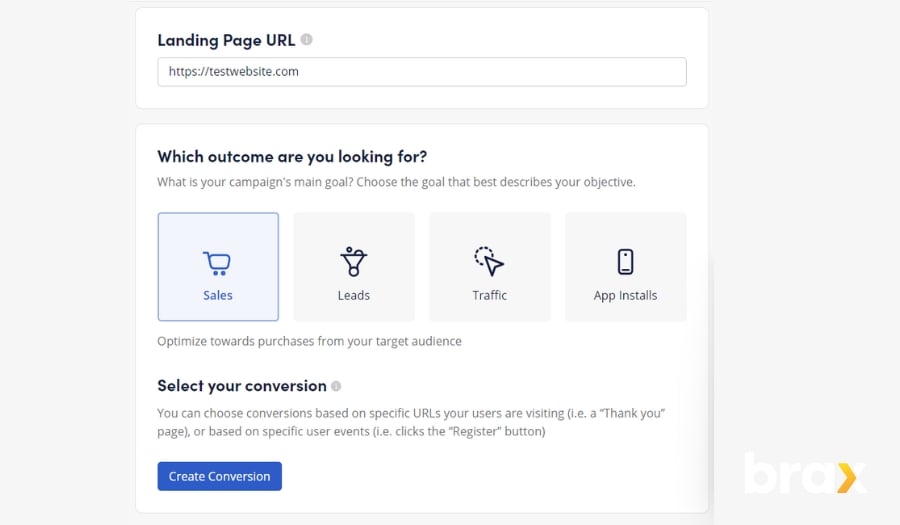
If you're seeing this, then you first need to head over to the Account Settings page then toggle the first option in the list, as shown below:
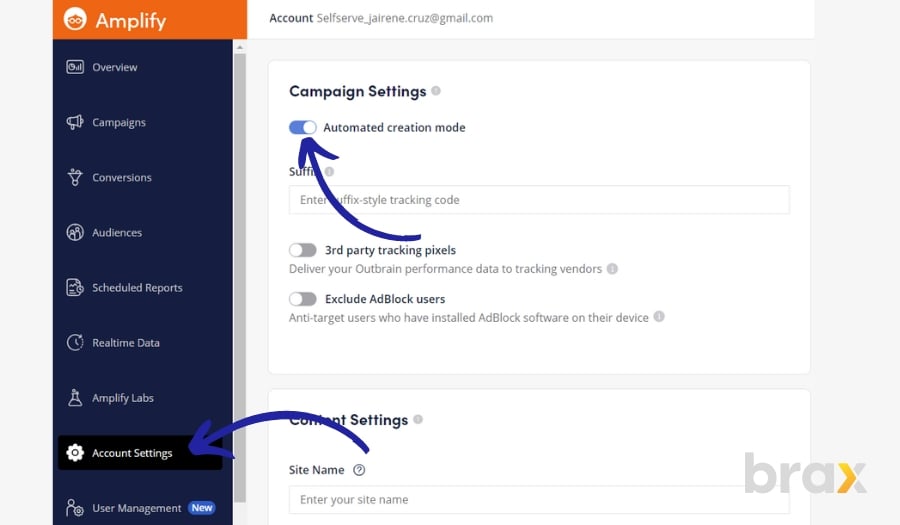
Click Save. The Advanced Targeting options for your native ads should now be available for you to use. When you head back to the campaign creation page, it will now be very different and will show extra filters.
These are:
- Placement Targeting Platform (Device) Targeting: Advertisers can focus on specific devices they want their ads to appear on, whether it's a Smartphone, Tablet, or Desktop. In Automated Mode, only Mobile and Desktop options are available.
- OS and Browser Targeting: Advertisers can tailor their ads to show up only on specific browsers or operating systems.
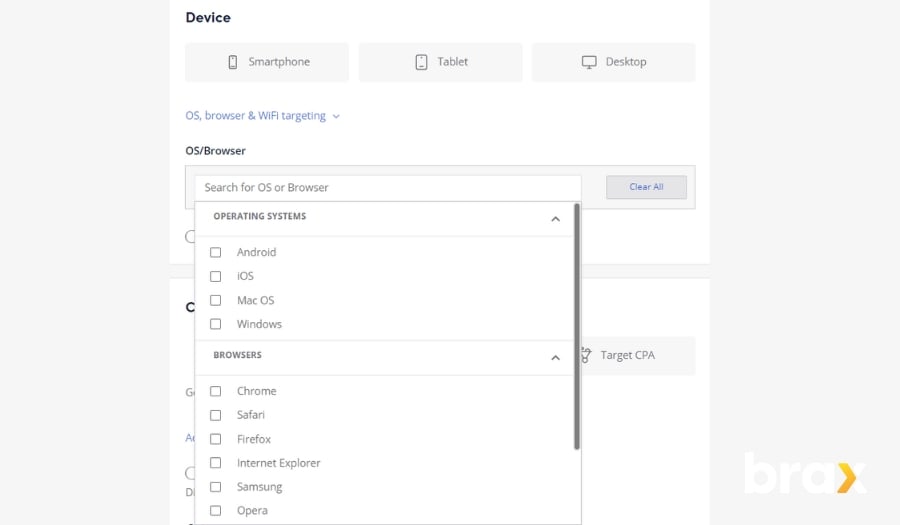
- WiFi Targeting: This option enables advertisers to serve their ads exclusively to mobile devices connected to WiFi. You can enable the toggle or leave it as is so the native ads are delivered to both 3G/LTE and WiFi.
- Location (Geo-Targeting): Advertisers can narrow down their target audience based on geographical location, including country, region, DMA, or zip code. Whatever you place here shows the add to people in that location. If you want to exclude them instead, simply toggle the Exclude Locations option.
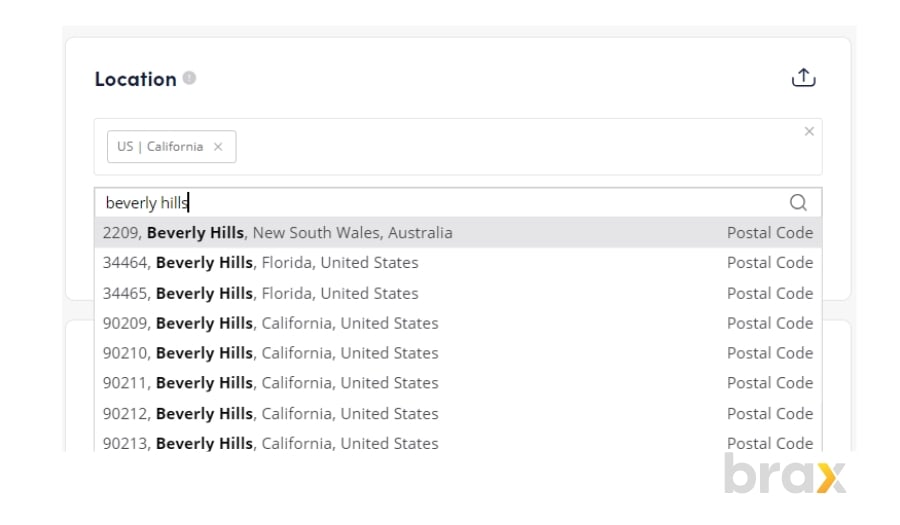
- Outbrain's Full Audience: Reach Outbrain's entire audience and let the native advertising platform's algorithm find the perfect target audience to help you achieve your objectives.
- Contextual (IAB) Targeting: The Interactive Advertising Bureau (IAB) plays a crucial role in the advertising industry, providing standards, guidelines, and best practices for advertisers, publishers, and marketers.
One of its key contributions is the IAB categories, a set of standard classifications for ad targeting. These categories help advertisers place their ads more accurately, ensuring they reach the most relevant audience.
Outbrain offers an impressive range of about 100 IAB category options for precise audience targeting. This means that advertisers can fine-tune their ad placements based on specific areas of interest, behaviors, or demographics.
Some of the IAB categories available on Outbrain include:
-
- Arts & Entertainment: This category includes sub-categories related to books & literature, movies, music, TV, fine art, and more.
- Business: Encompasses industries such as Agriculture, Construction, Finance, Advertising, Forestry, Marketing, and more.
- Health & Fitness: Covers areas like Exercise, Nutrition, Men's Health, Women's Health, etc.
- News: Sub-categories include International News, National News, and Local News.
- Sports: Includes Basketball, Golf, Soccer, and other popular sports.
These are just a few examples of the IAB categories available on Outbrain, each providing a potential avenue to reach a specific, engaged audience.
- Outbrain Interests: You can choose categories based on audience interest based on Outbrain's first-party data. There are two categories here, namely:
-
- Autos
- Business and Finance
- Electronics
- Entertainment
- Health
- Home and Lifestyle
- News
- Recreation
- Sports
- Technology and Internet
- Travel
-
These categories have useful subcategories that can help you really narrow down the audience interest.
- Attribute Targeting: Attribute targeting in Outbrain is an advanced technique that leverages third-party data to target individuals based on specific attributes.
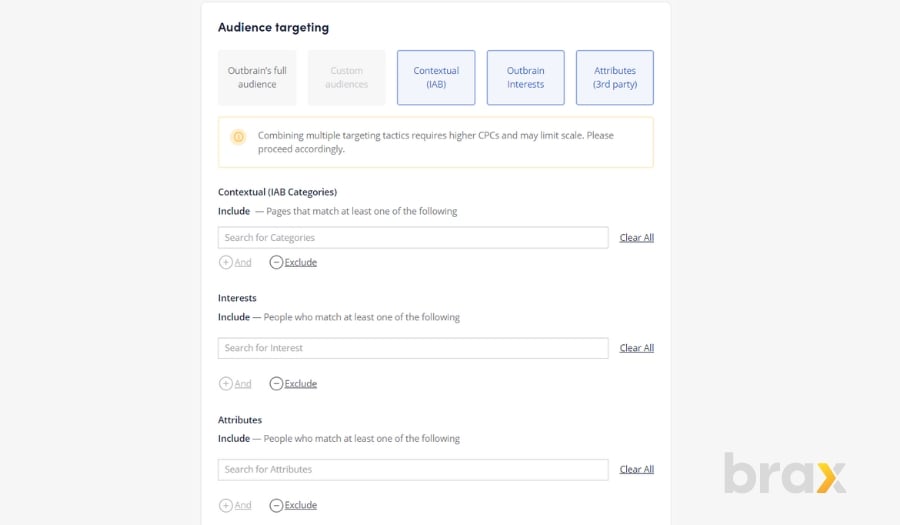
Note: For Audience Targeting, you can combine Contextual IAB, Outbrain Interests, and Third-Party Attributes.
- MSN Exclusively: Outbrain also offers exclusive access to Microsoft's MSN network. This includes the MSN News App, MSN Weather App, and some of Microsoft's Bing-run sites.
- High Impact Placement Targeting: Advertisers can capture consumer attention with brand-exclusive units served in the Smartfeed and in-article. Being high-impact also means it's high on demand, so the minimum bid of $2.
- AdBlock Targeting: This option allows advertisers to exclude users who have ad-blocking software installed. With this, you won't have to pay for impressions that most likely won't be seen due to ad blocking.
- Custom audiences: Advertisers can create custom audiences to retarget existing users, target campaign clickers, or target users who "look like" their existing users by creating lookalike audiences.
- Audience segmentation: Advertisers can select which audience segment to target or exclude.
- Importing first-party audiences: Advertisers can import their first-party audiences into Amplify using integrated DMP partners like LiveRamp or Oracle.
- Dynamic retargeting: Advertisers can customize targeting options for a new campaign or edit targeting for an existing campaign.
Audience Targeting in Taboola
When it comes to audience targeting in native advertising, Taboola stands out as a unique and powerful platform.
With its proprietary content discovery technology and access to an extensive network of premium publishers, Taboola offers unparalleled opportunities for advertisers to reach their desired audiences effectively.
The platform's sophisticated targeting capabilities allow advertisers to segment and reach audiences based on a plethora of factors.
This, combined with Taboola's predictive algorithms and machine learning capabilities, enables advertisers to deliver relevant content to the right people at the right time, thereby maximizing engagement and ROI.
Here's a quick rundown of Taboola's targeting options:
- Location Targeting: Ads can be tailored to certain countries, region or state, DMAs, city, or postal codes. You can opt to target multiple locations at once.
- Platform Targeting: Choose between desktop, mobile, or tablet for your native advertising display.
- Operating System Targeting: Target Android, iOS, Windows, Mac OS, etc.
- Browser Targeting: Choose to show or exclude ads on Chrome, Firefox, Safari, Internet Explorer, and others.
- Connection Type: Enable WiFi only if you want to reach an audience who has stable internet connection.
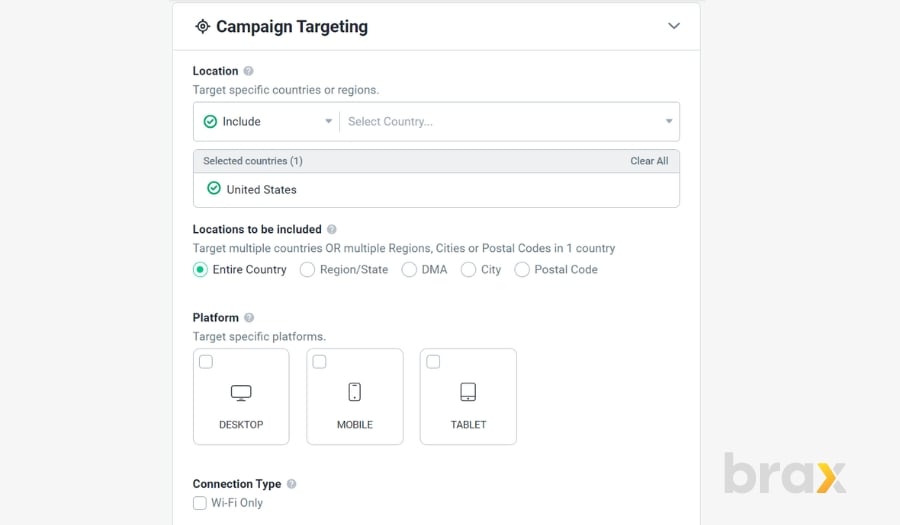
- Day Parting: Day parting in Taboola allows advertisers to schedule their campaigns for specific hours or days, ensuring that their content reaches the intended audience at the most optimal times. By strategically targeting peak hours or days of high user engagement, advertisers can maximize the effectiveness and efficiency of their Taboola campaigns.
- Demographic Targeting: Age groups and genders can be specifically targeted.
- Interest Targeting: Cater to users' interests and online habits.
- Audience Segmentation: Create unique audience segments using campaign data.
- Block Sites: Exclude specific domains and placements if you don't want your ads to be displayed there.
- Brand Safety Pre-Bid: This will ensure ads are shown in safe environments and are visible to users. Taboola's network of publisher sites and apps undergo scanning by third parties, who assign brand safety risk tiers across various topics. With the implementation of brand safety pre-bid targeting, Taboola ensures that your ad won't appear on sites and apps that don't meet your selected brand safety and suitability criteria.
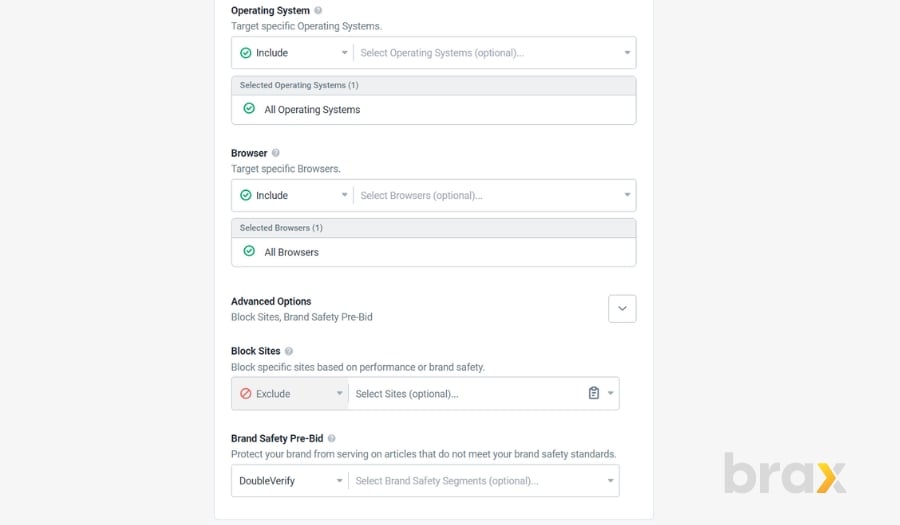
- Contextual Targeting: You can optimize ad targeting by tailoring native ads to the content users are viewing. With IAB contextual categories, you have the flexibility to both exclude and include websites based on their relevant contextual categories.
- Marketplace Audiences: These categories have been meticulously curated by Taboola using their extensive data, as well as trusted third-party sources.
Audience Targeting in MGID
Taboola is an exceptional platform for audience targeting in native advertising, but let's shift our attention to another powerhouse in this domain — MGID. This global pioneer in native advertising brings a unique blend of innovation and efficacy to the table.
Among all the top native advertising platforms, MGID probably has the least comprehensive targeting options.
Here are the available targeting filters:
- Geo-Targeting: This allows for setting up the geographic targeting of advertising campaigns, down to region, province, or state.
- Operating System (OS) Targeting
- Browser Targeting: You can target specific browsers for your campaigns. MGID provides 19 options.
- Browser Language Targeting: This feature allows you to target users based on the language they use in their browser.
- Mobile Connection Targeting: With this feature, you can target users based on their mobile connection, whether it's Wi-Fi or carrier data.
- Phone Price Range Targeting: This feature allows you to target users based on the price range of their phones. The price ranges include up to $150, $150 to $200, $200 to $300, and so on, until $700 and above.
- Audience Targeting: You can use this once you've set up your own audiences.
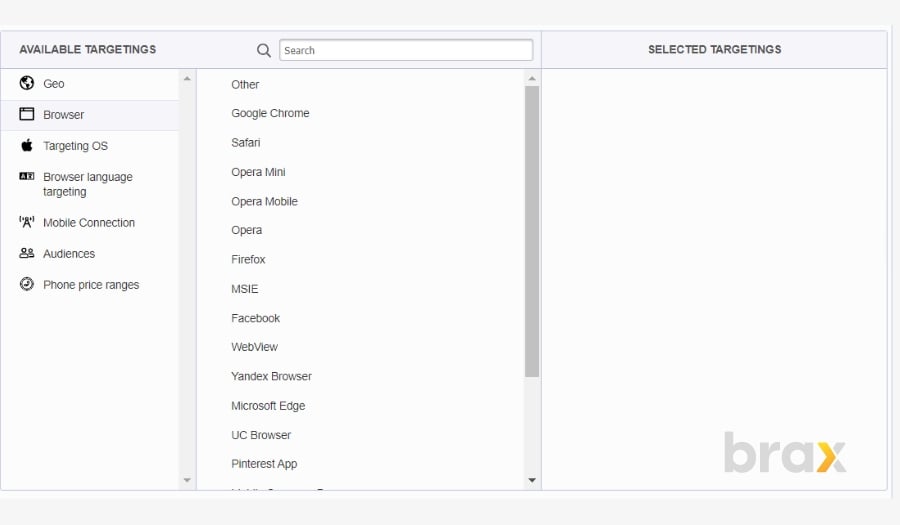
Audience Targeting in RevContent
When it comes to audience targeting, RevContent offers a range of options that can help advertisers reach their desired demographic.
However, while these features are robust and provide more specific targeting capabilities than some platforms such as MGID, they may not be as comprehensive as what's available on other platforms in the market.
Here are the RevContent's targeting filters:
- Country Targeting: Advertisers can target or exclude specific countries they're interested in. When targeting one particular country, they can further refine their targeting by region.
- Region Targeting: It allows advertisers to target specific regions within a country to make their campaign more localized and relevant.
- Zip Code Targeting: If promoting a regional campaign, advertisers can target corresponding zip codes. Alternatively, they can exclude any zip codes that they are not interested in. There's also an "upload CSV" option for an easier way to add lengthy lists of zip codes.
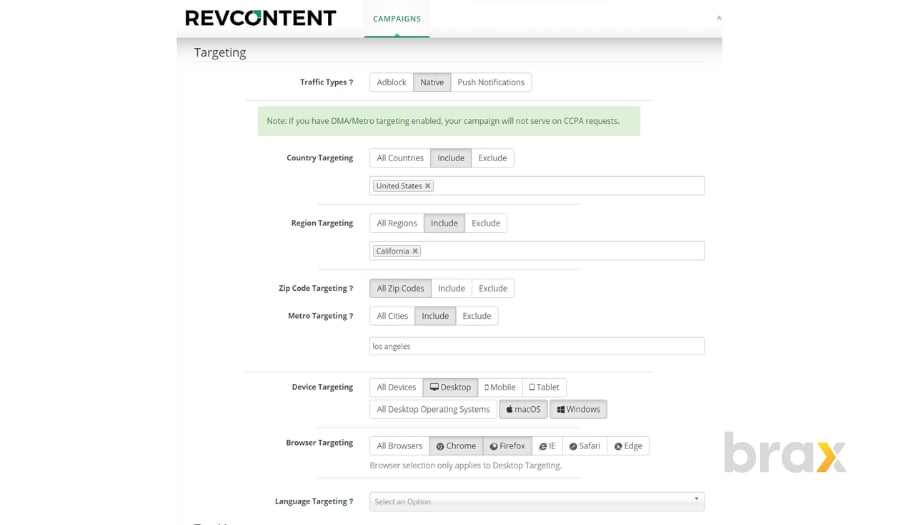
- Device Targeting: Advertisers can select which specific device type(s) they'd like to target.
- OS Targeting: This allows advertisers to target users based on their operating system (Android, iOS, Windows).
- Browser Targeting: Advertisers can target specific browsers for their campaigns.
- Metro Targeting: This tool allows advertisers to include or exclude entire metropolitan regions.
- Language Targeting: Advertisers need to select the language being used in the headlines of their campaign's content. If the language is not listed, they should select ALL. Selecting ALL languages when a more suitable choice is available, as well as selecting multiple languages, will result in a campaign denial.
Audience Targeting in Yahoo Gemini
Yahoo Gemini, a comprehensive native advertising platform, offers a wide variety of ad targeting options to help advertisers reach their ideal audience more effectively.
In fact, it's probably the most comprehensive out of all native ad platforms online, with the exception of Google Ads' native ads.
Here's a breakdown of the available options:
- WOEID (Where On Earth IDentifier): This is actually a location option that allows geo-targeting at the country, state, DMA, city, and zip code levels. If not specified, campaigns will default to global targeting.
- Device Targeting: Advertisers can set device bid modifiers for desktops, smartphones, and tablets. Campaigns can target specific devices, like iPhones or Samsung smartphones. However, once set, device targeting cannot be updated, only deleted.
- Site-by-Device Targeting (SITE_X_DEVICE): This allows native bid modifiers by site and device type. For instance, you can target users visiting the US homepage on desktops or the news section on mobile devices.
- Site Group-by-Device Targeting (SITE_GROUP_X_DEVICE): Similar to SITE_X_DEVICE, this option allows you to set native bid modifiers by site group and device type.
- Site Blocking (SITE_BLOCK): Advertisers can block their ads from appearing on specific sites in Native and App Install campaigns.
- Operating System Version (OS_VERSION): This targeting is available for the INSTALL_APP or REENGAGE_APP objective and targets users based on their device's OS version.
- Gender: Campaigns can target male or female audiences. Without specific gender targeting, campaigns will serve to all users.
- Segment: This refers to the interests of the targeted audience. If no segment targeting is set, the campaign will serve to all users.
- Radius: Based on a given latitude and longitude, advertisers have the ability to target users within a specific radius (in miles).
- Age: Campaigns can target specific age ranges. If no age targeting is set, all ages will be targeted.
- URL: This allows advertisers to block their native ads campaign from serving on specific domains.
- Ad Schedule (AD_SCHEDULE): This allows advertisers to set a schedule for their ads to serve on specific days and times of the week.
- Custom Audience: This refers to targeting a specific audience as per the custom audience section.
- Connection: This option is only for video ads, allowing targeting of WIFI or ANY connection types.
- Supply Group (SUPPLY_GROUP): This allows advertisers to set native bid modifiers by supply group.
- Third-Party Segment (SEGMENT_3P): This allows the targeting of third-party interest segments and their data providers in native advertising campaigns.
- Interest Segment (SEGMENT_INTEREST): This targets the interests of the audience. If no segment targeting is set, the campaign will serve to all users.
These targeting options provide advertisers with a wide range of choices to reach their ideal audience effectively.
Wrapping Up
To wrap things up, native advertising networks have opened a new frontier in audience targeting. These platforms provide an array of options — demographic, geographic, behavioral, and contextual targeting — each one a powerful tool for businesses to tailor their messaging and reach the right people.
These targeting capabilities ensure that advertisements are seen by those who are most likely to take an interest, thereby maximizing the effectiveness of ad spend.
But these tools must be wielded wisely. Businesses must understand their target market and the factors that influence buying decisions.
This isn’t a set-it-and-forget-it process. It demands continuous adjustment based on performance data and insights into customer behavior. If this task seems overwhelming, then you should leave it to the professionals, such as the Brax team!
If you're up to the task, then best utilize Brax native ads management platform to master the art of audience targeting and reach your goals. Our intuitive dashboard provides an easy-to-understand visual interface and enables tight control over every aspect of your native ad campaigns.
From there, you can make data-driven decisions to optimize your digital ads performance in real time. See it for yourself by booking a demo today.
By taking full advantage of these precise targeting options, businesses can foster deeper connections with their customers and achieve better results. This is the promise and potential of native advertising networks in our digital age.
If you like this post, then you might be interested in these as well:
- How to Build the Perfect Targeting Persona
- Create the Best Native Ads by Knowing Your Audience
- Niche Marketing: Earn Big by Targeting Small
- What is Target Marketing and How to Apply It to Your Business

